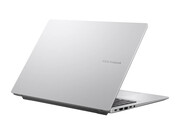Asus Vivobook 16 Serie
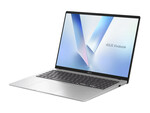 Processore: AMD Ryzen AI 7 350, Intel Raptor Lake-U Core 5 120U, Qualcomm Snapdragon X SD X1-26-100
Processore: AMD Ryzen AI 7 350, Intel Raptor Lake-U Core 5 120U, Qualcomm Snapdragon X SD X1-26-100Scheda grafica: AMD Radeon 860M, Intel Iris Xe G7 80EUs, Qualcomm Adreno X1-45 1.7 TFLOPS
Schermo: 16.00 pollici
Peso: 1.8kg, 1.88kg, 1.941kg
Prezzo: 850 euro
Media dei 3 punteggi (dalle 7 recensioni)
Asus Vivobook 16 A1605
Specifiche tecniche
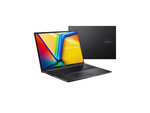 Notebook: Asus Vivobook 16 A1605
Notebook: Asus Vivobook 16 A1605Processore: Intel Raptor Lake-U Core 5 120U
Scheda grafica: Intel Iris Xe G7 80EUs
Schermo: 16.00 pollici, 16:10, 1920 x 1200 pixels
Peso: 1.88kg
Links: Asus homepage Asus sezione notebook
Price comparison
Punteggio medio:
recensioni esterne
Sorgente: Pokde
 EN→IT
EN→ITThe ASUS Vivobook 16 in Intel form will cost slightly more than its AMD counterpart at RM3,199, but just like the Team Red’s laptop, this is a budget workhorse for those who want to get things done without blowing a big hole into their wallets. However, I’d personally stick with the AMD version because there’s more multi-core performance on offer (which will be noticeable compared to single-core), even at a slight battery life deficit.
Singola recensione, disponibile online, Lungo, Data: 04/08/2024
Valutazione: Punteggio totale: 82% prezzo: 85% prestazioni: 83% mobilità: 80% qualità di lavorazione: 82%
Sorgente: Tech Critter
 EN→IT
EN→ITAt RM3,199, the ASUS Vivobook 16 A1605 delivers a compelling value proposition. The screen might be a limitation for specific uses, but the performance is surprisingly strong, even handling some games. I do recommend you check out this laptop if it suits your budget as we’re getting quite good value here. It’s just the screen that I wish was better.
Singola recensione, disponibile online, Medio, Data: 04/05/2024
Sorgente: NLT
 EN→IT
EN→ITSo, at the end, this laptop is RM3,199 and I think it’s quite good in terms of value. Sure, the screen is might be a problem for certain use cases, but the performance is actually really good. We can even play some games on it and I think that’s great. However, if you want something at around the same price but with more performance, then take a look at this MSI laptop. I’ll leave it at the end screen here – and if you have any questions about this ASUS Vivobook 16 A1605, leave them in the comments section below. I think it’s a great laptop for many people.
Singola recensione, disponibile online, Lungo, Data: 04/03/2024
Asus Vivobook 16 M1606K
Specifiche tecniche
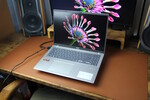 Notebook: Asus Vivobook 16 M1606K
Notebook: Asus Vivobook 16 M1606KProcessore: AMD Ryzen AI 7 350
Scheda grafica: AMD Radeon 860M
Schermo: 16.00 pollici, 16:10, 1920 x 1200 pixels
Peso: 1.941kg
Links: Asus homepage Asus sezione notebook
Price comparison
Recensioni in
Al prezzo di 999 euro, il Vivobook 16 potrebbe non eccellere nella qualità del display, nelle porte o in altre caratteristiche, ma i nuovi processori AI offrono sicuramente una forte dose di fascino di marketing.
Asus Vivobook 16 A1607
Specifiche tecniche
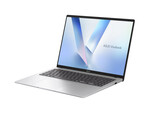 Notebook: Asus Vivobook 16 A1607
Notebook: Asus Vivobook 16 A1607Processore: Qualcomm Snapdragon X SD X1-26-100
Scheda grafica: Qualcomm Adreno X1-45 1.7 TFLOPS
Schermo: 16.00 pollici, 16:10, 1920 x 1200 pixels
Peso: 1.8kg
Links: Asus homepage Asus sezione notebook
Price comparison
recensioni esterne
Sorgente: NLT
 EN→IT
EN→ITStill, if you just want something simple – then the ASUS Vivobook 16 A1607 should be on your list. It’s supremely affordable at just RM2,999. I know that the price is enticing, but please know what you’re getting into before actually purchasing a Snapdragon laptop. I will say it again – app compatibility has improved a lot – and you can check out this website to find out if the apps you use are compatible or not – but compatibility does not mean the apps will run with the best performance possible. From experience, DaVinci Resolve and some games can be launched but the performance is… disappointing, to say the least. We have other videos to talking about Snapdragon laptops – do watch those videos and leave your questions down in the comments section below so that we can help you out.
Singola recensione, disponibile online, Medio, Data: 04/18/2025
Asus Vivobook 16 M1607KA
Specifiche tecniche
 Notebook: Asus Vivobook 16 M1607KA
Notebook: Asus Vivobook 16 M1607KAProcessore: AMD Ryzen AI 7 350
Scheda grafica: AMD Radeon 860M
Schermo: 16.00 pollici, 16:10, 1920 x 1200 pixels
Peso: 1.88kg
Prezzo: 850 euro
Links: Asus homepage Asus sezione notebook
Price comparison
Punteggio medio:
recensioni esterne
Sorgente: 91mobiles
 EN→IT
EN→ITThe VivoBook 16 M1607KA is not a statement piece. It is instead a sensible, large-screen laptop that quietly leverages AMD’s most advanced mainstream processor to deliver the kind of balanced experience most buyers actually need. The screen is roomy, the keyboard comfortable, the performance snappy, and the battery genuinely long-lasting. Shortcomings do exist. The panel is merely adequate for colour work, the port arrangement omits SD and Type-C charging, and the webcam could use an upgrade. Yet, weighed against the asking price, those flaws shrink. For students who juggle research, coding projects, and Netflix, for remote workers who crave a bigger canvas than a 13-inch ultrabook can provide, and for families who want one machine that handles homework by day and light gaming by night, the Vivobook 16 M1607KA represents strong value.
Singola recensione, disponibile online, Lungo, Data: 06/11/2025
Valutazione: Punteggio totale: 80% prestazioni: 80% schermo: 75% mobilità: 80% qualità di lavorazione: 80%
Sorgente: Cell Phones
 VN→IT
VN→ITPratico, disponibile online, Lungo, Data: 04/04/2025
Commenti
Asus: ASUSTeK Computer Inc. è un importante produttore taiwanese di hardware per computer con sede a Taipei, fondato nel 1989. Con il marchio Asus, l'azienda produce un'ampia gamma di prodotti, tra cui laptop, desktop, schede madri, schede grafiche, monitor, smartphone e apparecchiature di rete , sistemi completi e componenti PC per utenti finali.
Con il marchio ROG (Republic of Gamers), ASUS produce laptop da gioco conosciuti dai giocatori per le loro potenti specifiche, schede grafiche dedicate, display ad alta frequenza di aggiornamento e sistemi di raffreddamento avanzati.
Oltre ai giochi, viene offerta un'ampia gamma di notebook per esigenze e budget diversi, dagli ultrabook ultrasottili e leggeri ai versatili convertibili 2 in 1 e alle opzioni economiche. Nel 2023, Asus deteneva una quota di mercato globale del 7% del mercato dei PC.
La soddisfazione del cliente per i notebook ASUS riguarda le prestazioni, le caratteristiche e il buon rapporto prezzo-prestazioni dei notebook ASUS. Tuttavia, come con qualsiasi marca, ci sono segnalazioni occasionali di problemi come surriscaldamento, compatibilità dei driver o problemi di qualità costruttiva.
Ridurre la distanza delle Schede Grafiche per gli utenti che vogliono utilizzare il videogiochi. I nuovi giochi dovrebbero funzionare su queste schede, ma con riduzione dei dettagli e risoluzione mediocre.
Intel Iris Xe G7 80EUs:
Scheda grafica integrata nei SoC Intel Tiger Lake G7 basati sulla nuova architettura Gen. 12 con 80 EU (Execution Units / Shader Cluster). La frequenza di clock dipende dal modello di processore. I chip Tiger Lake sono prodotti nel moderno processo 10nm+ di Intel.
AMD Radeon 860M: Una iGPU con architettura RDNA 3.5 piuttosto potente che ha debuttato all'inizio del 2025 e che è il diretto successore della Radeon 760M. Le sue 8 CU/WGP (512 shader unificati) funzionano fino a 3 GHz. DX12 Ultimate, ray tracing, generazione di immagini AI e altre funzioni moderne sono tutte supportate, così come molti codec video popolari, tra cui in primo luogo AVC, HEVC, VP9 e AV1. Le sue prestazioni di gioco sono abbastanza buone per giocare a 2024 giochi con impostazioni grafiche basse.
Qualcomm Adreno X1-45 1.7 TFLOPS: Un adattatore grafico integrato che il SoC Snapdragon X Plus 8-core X1P-42-100 presenta. Rispetto alle più veloci iGPU X1-85 da 3,8 TFLOPS e 4,6 TFLOPS, questa non solo funziona a velocità di clock inferiori, ma dispone anche di un numero inferiore di shader unificati, con 768 come numero più probabile. L'architettura di base, a quanto pare, non è molto diversa da quella utilizzata nell'Adreno 730. Per quanto riguarda le prestazioni di gioco, è appena sufficiente per i giochi pre-2020 a risoluzioni come HD 720p con impostazioni grafiche basse.
>> Ulteriori informazioni le potete trovare nel nostroConfronto delle schede grafiche e nella nostra Lista dei Benchmark.
Intel Raptor Lake-U:
Core 5 120U: Processore mobile di fascia alta basato sull'architettura Alder Lake. Offre 2 core di prestazioni e 8 core di efficienza e può elaborare 12 thread contemporaneamente. Il turbo clock massimo dei core P è di 5 GHz.
AMD :
Ryzen AI 7 350: Un processore relativamente potente della famiglia Strix Point che ha debuttato nell'ottobre 2024. L'APU ad architettura ibrida presenta 8 core di CPU (un mix di core Zen 5 e Zen 5c) che funzionano fino a 5,0 GHz, insieme all'adattatore grafico Radeon 880M e al motore neurale XDNA 2 di 50 TOPS. Il Secure Processor di AMD (che in poche parole è un co-processore ARM on-package) è presente a bordo, così come alcune altre caratteristiche di fascia alta, come AMD-Vi. Altre caratteristiche chiave sono PCIe 4, USB 4 e supporto RAM fino a LPDDR5x-8000, compresa la RAM ECC. L'obiettivo di potenza TDP a lungo termine può arrivare a 55 W.
Qualcomm Snapdragon X:
SD X1-26-100: Un processore con architettura ARM (SoC) conveniente da utilizzare nei computer portatili Windows. Il chip X Plus a 8 core presenta 8 core di CPU Oryon che funzionano fino a 2,98 GHz, insieme all'iGPU X1-45 Adreno da 1,7 TFLOPS e alla NPU 45 TOPS Hexagon. Il controller di memoria LPDDR5x-8448 superveloce, conosciuto da altri chip Snapdragon X, il supporto USB 4.0, il supporto TB 4 e il supporto PCIe 4 sono tutti presenti.
>>Ulteriori informazioni le potete trovare nel nostroConfronto dei processori per portatili.
>> Per scoprire come è la risoluzione del vostro schermo, andate a vedere la nostraLista DPI.
1.8 kg:
Di solito subnotebooks, ultrabooks e portatili leggeri con diagonale del display da 12-16” pesando di più.
1.941 kg:
79.87%: Il punteggio ottenuto non convince. Bisogna considerare che difficilmente altri portatili hanno ricevuto un punteggio inferiore al 60%. Questo portatile è stato giudicato sotto la media, pertanto non possiamo consigliarne l'acquisto.
>> Ulteriori informazioni le potete trovare nella nostra Guida all'acquisto di un portatile.




